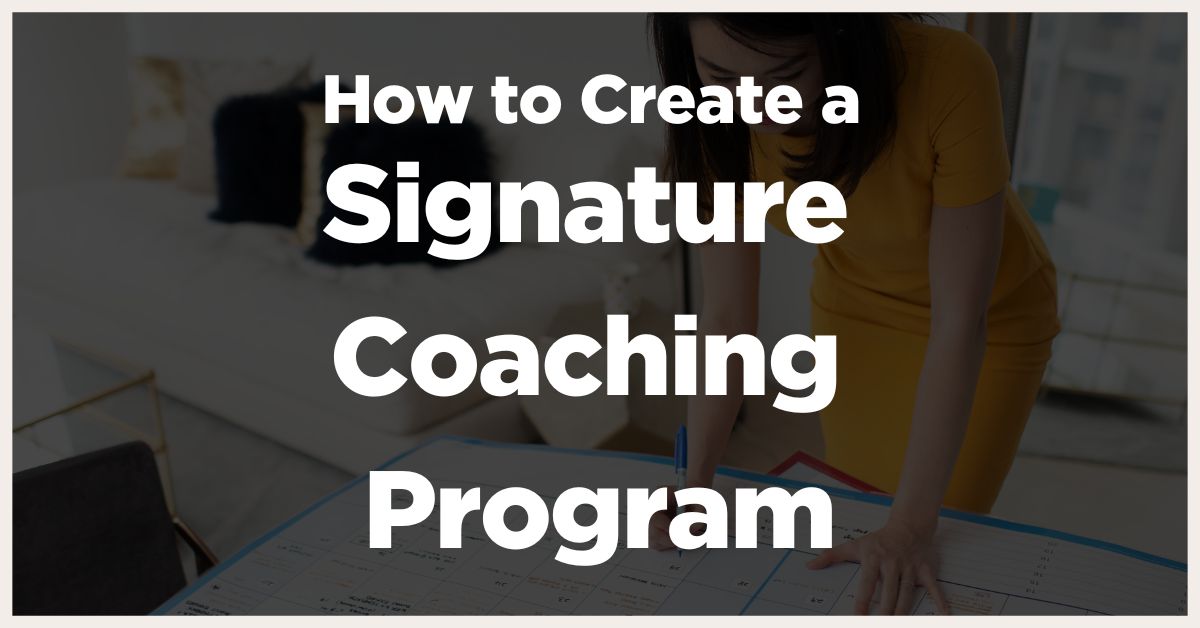Are you building your first coaching program?
You’ve come to the right place. Today, you’ll learn how to create an online coaching program and a template you can use to design your signature coaching process.
Ready to create a transformative coaching program that works? Let’s get started.
How do you create stand-out coaching programs?
As an online coach, you support your students in achieving impactful results. Just like I explain in this short video:
A coaching program is your package offer to your new clients. It’s your signature process. The thing that makes YOU the coach to go to for results in your niche.
Coaching program templates are extremely helpful tools to create your packages. A template is simply an outline of the program that you use to create those results. Each coaching program outline will be different depending on your niche, skills, and clients.
Take a health coach, for example.
A health coaching package may involve weigh-ins, meal planning, and weekly calls.
On the other hand, a business coaching program is more about mindset and strategy.
BUT the elements of every coach’s process are generally the same. We’ll talk more about that later. First, do you even need a template or can you just go with the flow? Well…
Do you need a coaching program template?
Let me put it this way:
Every coach needs an amazing package to offer clients. Your clients are looking for transformation, support, and actionable results. Your program is how you help them get there.
So, if you want to succeed as a coach, you need to create a program that people love.
Because here’s the thing: If your coaching program is packaged in the right way, you can make six figures – or more.
But, to make those kinds of numbers, your coaching program has to be clear, valuable, and highly attractive to the RIGHT clients.
Clearly, the coaching program is the value. So, is a template really necessary?
By designing a coaching program using a template, you make sure you cover all the bases of your coaching offer.
Get the Ultimate Guide
for building a
6-Figure Coaching Business so you can achieve more freedom!
With a template, you can define your signature process that takes clients from A to B.
Also, once you have a defined coaching program, it’s way easier to tweak it for better results in the future. Every client will teach you something new.
Your first coaching program will look very different from your fifth. So, don’t worry if the first program you create is too rigid. You’ll adapt as you gain more experience as a coach.
And the best part?
Clients LOVE a clear structure for their coaching program.
Why? Because it shows them the exact transformation they can expect and the steps you’ll take together to get there.
Scaling your coaching business with group coaching programs
Eventually, you can even scale your coaching program to group coaching. Group coaching is the process of coaching multiple clients at the same time and in that way scaling your program.
Once you have a tried and tested program template that has worked for private clients, scaling gets much easier.
With that said, I don’t recommend starting a group coaching program until you have some experience creating results on a one-on-one basis. But, when you’re ready, a group coaching package is a great way to take your business to the next level.
(If you want to learn more about group coaching programs, read more in this article on what it takes to create group coaching packages.)
Ultimately, a coaching program template helps you define a process that will get you clients.
But are coaching templates formulaic? How can you build a signature process from a template?
Let’s find out.
The secret to creating a signature coaching style
The first thing to understand is that a coaching template is just a guide.
What do I mean by that?
Creating a signature coaching program is part of what makes you stand out. Clients will choose YOU because they resonate with your program content, offer, and results.
The base of most coaching programs may be the same, but you have to know how to customize it for your clients.
So, how do you do that?
First, look around at the other coaches in your niche. Don’t copy, but try to understand the current offers on the market. Competitor analysis is key to building any successful business.
Once you have a good grasp on what the other coaches in your niche are doing, focus back on you and your skills.
What elements of your education or experience are unique to you? Is there a technique or offer that you want to include in your coaching program that others don’t? What’s your secret sauce?
From there, focus on ONE core offer for your package. Your coaching package will naturally have many benefits. You’ll be supporting clients as they achieve their goals, after all. There are so many transformative results that come with that.
But I challenge you to focus on the one thing you do really well.
For example, as a parenting coach, you might say, “I help new mothers learn mindfulness techniques for stress relief.”
Great! That’s a clear offer. You have an ideal client – new mothers – and one key result – teaching mindfulness for stress relief.
Give it a try. Think about one solid result you can guide your clients to achieve.
This is just one way to stand out as a coach. You can also create a signature coaching style by having alternative methods or an underserved niche.
Now that you have a niche and a clear goal, let’s start building your new program.
How do you start a coaching program?
Your coaching program is the core of your services. But, before you can sell it, you need to know what you’re selling.
So, in this section, we’ll focus on the basics of building a signature program. In the next section, we’ll go into more detail about structure and how to personalize a coaching program template.
Sound good? Let’s dive in.
What makes a coaching program successful?
My first piece of advice is, don’t overthink this.
Remember: This isn’t the fixed program that you’ll use throughout your coaching career. You won’t get clarity on everything your coaching package should include until you’ve coached your first 1-3 clients. And that’s okay.
To give you a guideline and help you figure out what your signature coaching program template should include, ask yourself these two questions:
- What does the program promise?
What you promise in your coaching program is the unique selling proposition. In other words, it’s that one result your clients can expect from working with you. You want the promise to be highly valuable and enticing to the RIGHT clients.
How do you figure that out? By understanding who your client is. This leads to the second question you should ask yourself:
- Who is the program for?
Your ideal client is the client who will most appreciate and benefit from your coaching services. Think about their age, life stage, and income. Most importantly, think about the problems this client has that YOU can solve.
I recommend speaking to an ideal client on the phone and asking them about their pain points related to your coaching niche. Their answers might surprise you.
Pay attention to the language they use because it’ll help you market your online coaching services when your package is ready.
For more on successful offers, check out this short video:
How long should your program be?
Coaching packages are flexible, but there are some industry standards to keep in mind.
For me, three months is the sweet spot for new coaches.
Why? Think of it this way:
One or two months is too short to have any major behavior changes. You would have to promise a small transformation, which is less valuable to potential clients and harder to sell.
Six months can give you a ton of time to create transformative results, but it’s also a huge commitment for you and the client. If you’re new to the game, it’ll be tough to charge what six months of coaching is truly worth.
That’s why three months is the perfect in-between. It’s long enough to help your client create an amazing result, but it’s also short enough to feel manageable.
Remember: This is my advice for beginners. After you gain some experience, you might change your program to be longer and more valuable.
So, now that you’ve figured out how long your program should be, how much should you charge for it? That’s a big question. Let’s talk about it.
How much should you charge for your coaching program?
According to the Harvard Business Review, the average salary for coaches is $500 an hour. That’s a pretty great wage.
But remember: Getting to that point takes practice and experience. In the beginning, you’ll probably be making a little less – but not for long.
Coaches have the potential to earn six figures – or multiple six figures – with just one package.
There are many ways to structure pricing for your coaching business, too. You can set a price per hour, per week, per month, or per package.
My take? Per-package pricing is the best fit for most coaches.
Why? Because it gives your client a clear value proposition. You pitch a set length of time and one clear transformative result for a fixed package price. Your client understands the ROI.
And, even better, it’s easier to sell coaching services per package.
So, how much should you charge for the package?
As I said, some coaches charge tens to hundreds of thousands of dollars for their coaching. That’s usually after testing the market, building a huge audience, and having a ton of experience.
In the beginning, don’t overthink this.
I recommend charging $1,500 for three months of weekly coaching. If you want to offer a payment plan, offer three installments of $550.
Why does this work? Because it provides great value for the client. They get your support and the transformative result they’re looking for.
Plus, for that price, it’ll be easy to pitch clients on the clear value they’re getting.
For more about program structure and pricing, check out this video:
How do you structure a coaching program?
Now that you know the value of a coaching program and what you should include in your package, what is the coaching formula? Let’s look at how you can build your own.
(Psst, I’ve created a downloadable template that you can use alongside this article to create your signature process. Check it out below!)
Set a clear goal for your package
Remember the one thing you’re known for? Ultimately, your program needs to achieve that one goal.
But there’s more to it than just your signature result. You’ve got to personalize it to your client.
So, how do you do that?
Let’s take an example.
Say you’re a health coach for female entrepreneurs.
Great – that’s a clear niche.
Your goal is to help your clients create healthy eating habits so they’ll have more success in their business life.
This is the line you’ll put in your template. It’s clear and focused on ONE result.
But when you get your first client, you can customize the goal to their specific needs.
For example, imagine your client is addicted to fast food. As a busy entrepreneur working crazy hours, she just picks up food whenever she can get it.
So, her goal as part of your package is to improve her diet by making more healthy meals at home.
That still works with the overall goal of your package, but you’ve narrowed down a specific personal goal for the client in front of you.
Important note! You don’t want to offer a customized offer. So don’t change up the length, price, or the “secret sauce” you’re selling. I explain more here:
A few examples of other coaching business offers include my client Emily who coaches people to find work they love.

Or Ruby, who is a relationship coach for men:

Now it’s your turn.
Think about the one promised result that your client really wants. It needs to be specific enough to sell as a clear offer in your coaching package, and it also has to be broad enough to personalize to your clients.
Worked out the goal of your offer? Great! Now let’s figure out how you’ll achieve that goal with your clients.
Decide on your coaching tools, tactics, and activities
Your coaching tools, coaching methods, and activities are the “how” of your coaching program.
In other words, how do you help your clients achieve the goals they set in the first stage?
You could choose many different techniques to help your clients succeed.
Here’s a list of things you could include:
- Done-for-you plans (e.g. workout plans, meal plans, etc.)
- Worksheets (e.g. journal prompts)
- Templates (e.g. schedules, do-it-yourself plans)
- Resources (e.g. books, ebooks, and videos that you make or curate)
No matter how you choose to deliver your program, make sure it aligns with your brand and actually works. That’s really important.
But don’t get too caught up on the “how” in the beginning. It’s better to create many of these resources as you go. Keep in mind that by working with clients, you’ll learn more about their pain points and struggles over time.
Create a rough guide of how you want to deliver your program, but remember: Improvement is key to future success. You’ll probably change your process a few times until you create the perfect formula.
So, now you’ve got the “what” and the “how” of your offer. Let’s talk about the “when.”
Plan for success
If you’re creating a 12-week coaching program, you need a flow.
But how do you design an outline? It’s easier than you think.
Start with goal setting and the “first assessment.” That’s when you assess where your client is at before the program starts so you can build realistic milestones for their goals.
After that, map out those milestones for every week you’ll be coaching your client.
For example:
Month 1 – Support your client in making one behavioral change every week.
Month 2 – Add in physical exercise every week.
Month 3 – Combine the two and solidify your client’s new, healthy habits.
From there, you can start mapping out your online program. Every session should have its own milestone that ultimately supports the monthly milestone and overall goal. (Note: You’ll figure out those goals as you coach your first clients.)
How to hold stand-out coaching sessions
Great coaches lead their clients through a process to help them attain a specific result – not just by asking questions, but by becoming trusted guides. Imagine yourself as the Google Maps to the goal your offer promises.
Your coaching sessions are calls that continually guide your client forward to the next milestone of their goal.
Get the Ultimate Guide
for building a
6-Figure Coaching Business so you can achieve more freedom!
Planning coaching sessions
Now, outlining a coaching session plan will help you stay organized, but I don’t recommend it for beginners.
Why? Because it’s pretty tough to do before you’ve started coaching clients in real life. Instead, use the notes from each coaching session to design the next one.
Understandably, the first coaching call is crucial. So, outline this call in as much detail as necessary. For the first coaching call I ever did, it took me three hours to write a complete script.
YES, three whole hours (I talk more about it in this article about coaching sessions).
You might need less than that, but a list of bullet points to cover can help you feel more confident.
During the call, make notes on what your client wants to focus on.
That way, after your first successful coaching call, you can write the outline for the next coaching session.
Once you’ve coached three or four people, you’ll start to notice the same topics covered at each stage of your program. Using that information, you can then make a coaching session outline that works.
Want more tips on how to coach effectively? Check out this video:
You’re almost ready to launch your coaching program into the world. But first, the final part is figuring out the logistics. Let’s do it.
Deciding on your coaching session setup
A simple setup for a 90-day coaching program goes like this:
A bi-weekly or monthly 45-60 minute coaching call with additional in-between support (through Voxer, email, or whatever tool feels best to you).
The point is to overdeliver here. Remember: You need great feedback to get your coaching business going, and offering a lot of value is one surefire way to get it.
But what about the in-between support? What does that even mean?
In-between support gives your clients the option to reach out to you about any small questions or concerns they may have during the program. A full extra call during the week is unnecessary.
Instead, use texts, emails, or Voxer to keep open communication with clients between calls. Some clients will use that extra support, and many won’t.
What’s important is that they have the option to reach out to you if they need to. It’s a key part of making your clients feel taken care of.
So, what channels will you keep open for clients? What kind of availability can they expect from you?
Now, I’m not suggesting that you should keep the same support structure forever. You might decide to reduce your availability six months after becoming a coach.
But, in the beginning, offer your new clients plenty of support, and invest your time in learning how to be a great coach. As you hone your skills, you’ll get better at helping your clients achieve their goals while working fewer hours.
Grab your own signature coaching program template
Ready to make your own transformative coaching program? I’ve made an easy coaching program template you can use. Just follow the guidelines in this article to fill in the template, and there you have it.
Signature Coaching Program Template
Client:
Offer name:
Coaching package goal:
Month 1
Goal:
First session milestone:
Second session milestone:
Month 2
Goal:
First session milestone:
Second session milestone:
Month 3
Goal:
First session milestone:
Second session milestone:
Frequently asked questions
Why are coaching programs important?
Coaching programs are at the heart of your coaching business. After all, they offer the structure you need to help your ideal clients achieve their desired outcome and transformation. Programs map out your coaching journey and the steps you take to support a client’s success.
What are the core skills of a coach?
The core skills of a coach are to support and guide their students. What do I mean? Well, instead of just thinking of coaching as a way to let your students find the answers themselves, think of yourself more like a “coach-sultant” – you help your students find the answers themselves but use your own coaching experience where it’s relevant to guide your students to their goal.
Over to you!
Now you know how to design your own signature process with a coaching program template. I hope the template helps you build a coaching offer that works for you and your clients.
Got questions? Comment down below.








